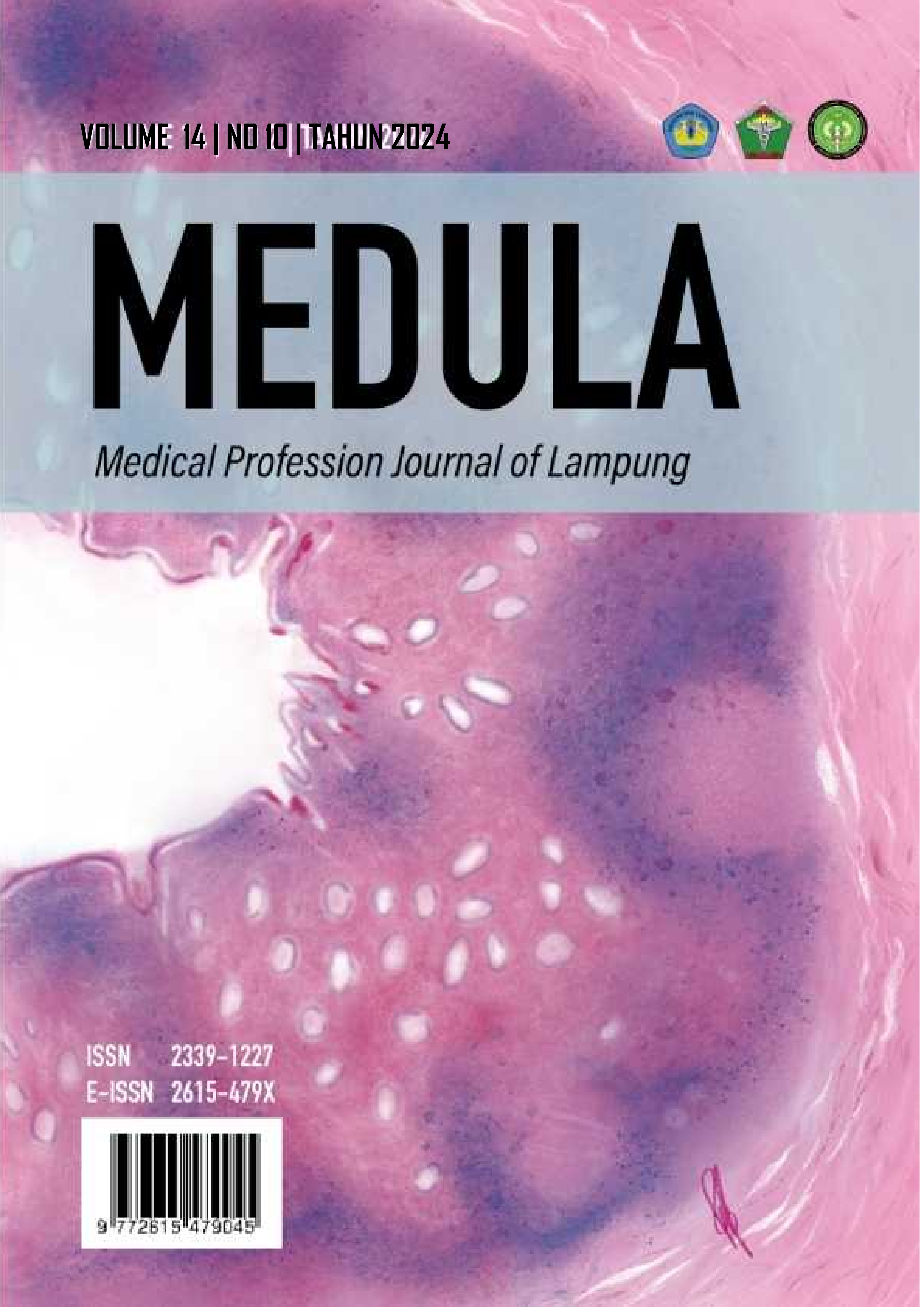Transient Ischemic Attack : The Challenge in Diagnostic
DOI:
https://doi.org/10.53089/medula.v14i10.1360Keywords:
Stroke, Transient Ischemic Attack (TIA), Neurological Deficits, ABCD² scoreAbstract
Stroke is a condition characterized by the rapid development of clinical signs of focal and global neurological deficits, which can worsen and persist for 24 hours or more, potentially leading to death, with no clear cause other than vascular. Transient Ischemic Attack (TIA) is a temporary neurological dysfunction caused by a blockade or reduction in blood perfusion to brain tissue, lasting from a few seconds to minutes, and in some cases, up to 24 hours. Diagnosing TIA is challenging because patients typically present after the TIA has resolved, making it crucial to diagnose TIA clinically before confirming the diagnosis with additional examinations such as CT-Scan or MRI. There are meta-analysis studies that describe the role of certain biomarkers in supporting the diagnosis of TIA. Due to the closely related pathomechanisms between TIA and ischemic stroke, almost all the same biomarkers can be used to diagnose both conditions. There are scoring systems used to identify the risk of stroke in patients with TIA, with the ABCD² score being the most commonly used. Rapid assessment and the implementation of adequate therapy reduce the risk of TIA progressing to ischemic stroke.
References
Iskandar A, Hadisaputro S, Pudjonarko D, Pramukarso DT. Gaya Hidup yang Berpengaruh terhadap Kejadian Stroke Iskemik pada Usia Kurang dari 45 Tahun (Studi Pada BLUD RSUD Cut Nyak Dhien Meulaboh Kabupaten Aceh Barat Provinsi Aceh). Jurnal Epidemiologi Kesehatan Komunitas. 2018; 3(2): 54–62.
Khariri, Saraswati RD. Transisi Epidemiologi Stroke sebagai Penyebab Kematian pada Semua Kelompok Usia di Indonesia. Seminar Nasional Riset Kedokteran (SENSORIK II). 2021; 81–86.
Kementerian Kesehatan RI. Survei Kesehatan Indonesia 2023 dalam Angka. 2023. Jakarta: Kemenkes RI.
Ortiz-Garcia J, Gomez CR, Schneck MJ, Biller J. Recent Advances in The Management of Transient Ischemic Attacks. Faculty Reviews. 2022; 11(19): 1-18.
Çoban EK, Senadım S, Yılmaz A, Küçükoğlu H, Köksal A, Ataklı D, Dkk. The Review of Transient Ischemic Attack Patients; An Experience of A Clinic About Diagnosis and Follow-up. The Medical Bulletin Of Sisli Etfal Hospital. 2020; 54(1): 83–87.
Amin HP, Madsen TE, Bravata DM, Wira CR, Johnston SC., Ashcraft S, Dkk. Diagnosis, Workup, Risk Reduction of Transient Ischemic Attack in the Emergency Department Setting: A Scientific Statement From the American Heart Association. Stroke. 2023; 54(3): 109–121.
Sorgun MH, Özaydın Aksun Z, Erdoğan S, Arslan M, Gürsoy Çoruh A, Kuru Öz D, Dkk. The Effects of a “Transient Ischemic Attack Unit” on the Early Diagnosis and Treatment of Stroke and Other Vascular Events. Turkish Journal Of Neurology. 2023; 29(1): 18–23.
Lip GY, Genaidy A, Estes C, McKay D, Falks T. Transient Ischemic Attack Events and Incident Cardiovascular and Non-Cardiovascular Complications: Observations from A Large Diversified Multimorbid Cohort. European Stroke Journal. 2023; 8(1): 334–343.
Chaswal M. Transient Ischemic Attack: Timely Diagnosis and Early Intervention. International Journal of Health Sciences. 2019; 9(5): 367–375.
Amarenco P. Transient Ischemic Attack. New England Journal of Medicine. 2020; 382(20): 1933–1941.
Coutts SB. Diagnosis and Management of Transient Ischemic Attack. CONTINUUM: Lifelong Learning in Neurology. 2017; 23(1): 82–92.
Shahjouei S, Seyedmirzaei H, Abedi V, Zand R. Transient Ischemic Attack Outpatient Clinic: Past Journey and Future Adventure. Journal of Clinical Medicine. 2023; 12(4511): 1-20.
Sorensen AG, Ay H. Transient Ischemic Attack: Definition, Diagnosis, and Risk Stratification. Neuroimaging Clinics of North America. 2011;21(2): 303–313.
Edlow JA. Managing Patients with Transient Ischemic Attack. Annals of Emergency Medicine. 2018; 71(3): 409–415.
Simmatis LER, Scott SH, Jin AY. The Impact of Transient Ischemic Attack (TIA) on Brain and Behavior. Frontiers in Behavioral Neuroscience. 2019; 13(44): 1-6.
Nouri-Vaskeh M, Khalili N, Sadighi A, Yazdani Y, Zand R. Biomarkers for Transient Ischemic Attack: A Brief Perspective of Current Reports and Future Horizons. Journal of Clinical Medicine. 2022; 11(4) : 1–18.
Fonseca AC, Merwick Á, Dennis M, Ferrari J, Ferro JM, Kelly P, Dkk. European Stroke Organisation (ESO) Guidelines on Management of Transient Ischaemic Attack. European Stroke Journal. 2021; 6(2): 163–186.
Perry JJ, Yadav K, Syed S, Shamy M. Transient Ischemic Attack and Minor Stroke: Diagnosis, Risk Stratification and Management. Canadian Medical Association Journal. 2022; 194(39): 1344–1349.
Tursunova M, Khaydarov N, Abdullaeva M, Abdukodirov E, Nazarova M. Significance of Transient Ischemic Attacks (TIA) in the Development and Course of Ischemic Strokes. International Journal of Health & Medical Sciences. 2021; 4(2): 215–219.
Mendelson SJ, Prabhakaran S. Diagnosis and Management of Transient Ischemic Attack and Acute Ischemic Stroke: A Review. JAMA. 2021; 325(11): 1088-1098.
Park MH, Lee SH, Jung JM. Recurrent Ischemic Stroke and Transient Ischemic Attack: Risk of Single and Multiple Recurrence. Journal of Clinical Medicine. 2024; 13(5744): 1-12
Downloads
Published
How to Cite
Issue
Section
License
Copyright (c) 2025 Medical Profession Journal of Lampung

This work is licensed under a Creative Commons Attribution-ShareAlike 4.0 International License.














